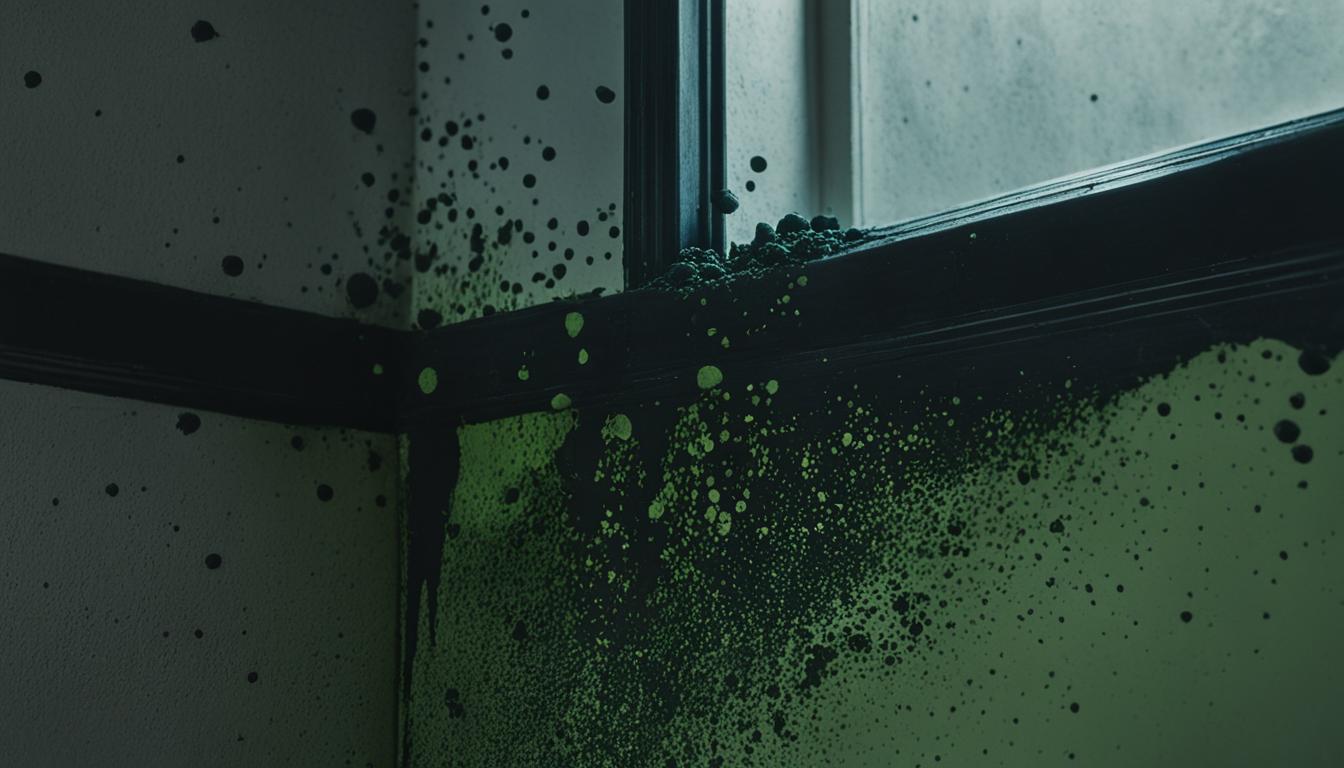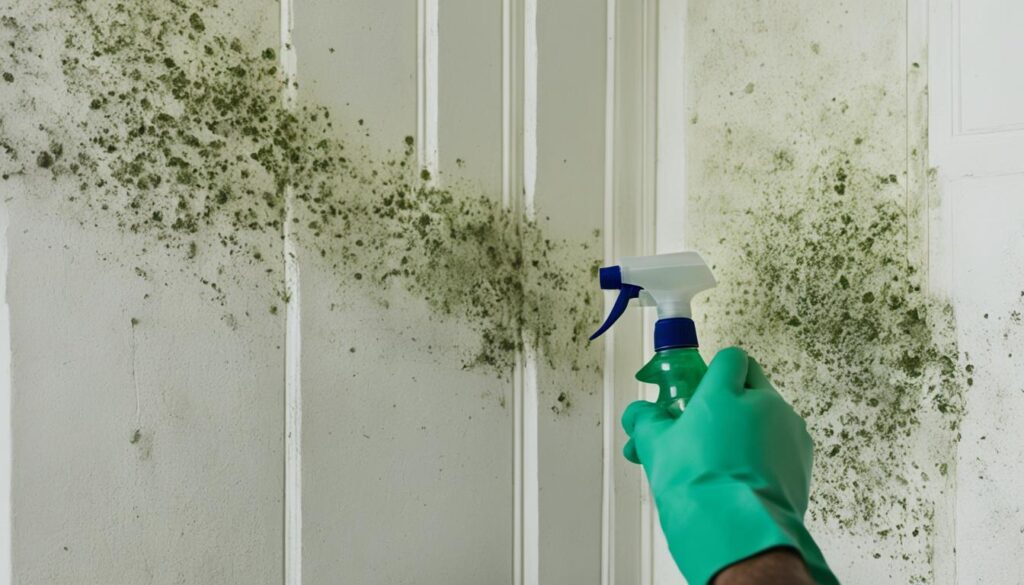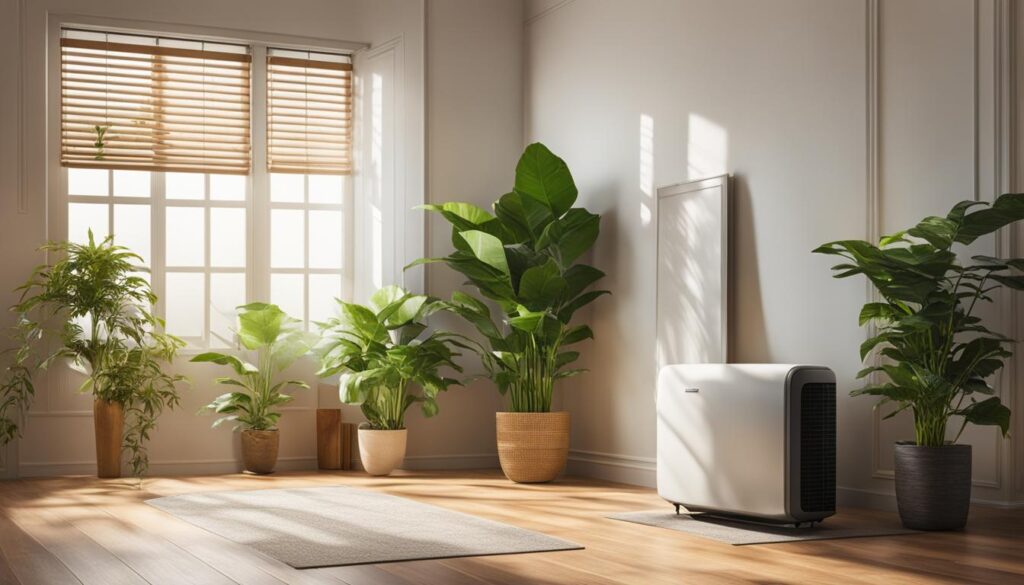
Effective Solutions to Fix Mold in House Safely
If you’re dealing with mold in your house, you’re not alone. Mold growth is a common issue that many homeowners face, but it’s essential to address it promptly to ensure it doesn’t cause health problems or damage to your property. In this section, we will discuss safe and effective solutions for fixing mold issues in your house, including mold removal, remediation, and inspection.
Key Takeaways:
- Mold growth is a common issue for many homeowners.
- It is crucial to address the issue promptly to prevent health problems and property damage.
- Solutions for fixing mold in your house include mold removal, remediation, and inspection.
- Do-it-yourself methods for initial mold removal are available, but professional assistance may be necessary for larger infestations.
- Preventive measures such as proper ventilation, reducing humidity levels, and regular maintenance are crucial for inhibiting mold growth.
Understanding the Dangers of Mold
Although mold is a natural part of our environment and plays a vital role in breaking down organic matter, it can also present serious health and safety risks when it grows in our homes. Mold can cause respiratory issues, allergic reactions, and even structural damage to your home if left untreated. Therefore, it’s crucial to address any mold growth immediately and take steps to prevent it from returning.
Professional mold services offer a range of solutions to effectively remove and prevent mold infestations. Hiring mold removal experts comes with numerous benefits, such as detecting the source of the problem, providing safe and effective mold removal, and reducing the risk of future outbreaks. Additionally, professional mold services can provide advice on mold prevention strategies tailored to your specific situation.
“Mold is not something that can just be ignored. Its presence can create health risks for your family and the structure of your home.”
Identifying Mold in Your House
Mold is often invisible to the naked eye, making it challenging to spot early on. However, it’s crucial to identify mold growth as soon as possible to prevent further spreading and potential health risks. One way to detect mold in your home is through regular mold inspections. These inspections can be done by professional mold inspectors or by using DIY mold testing kits.
If you suspect mold growth in your house but want to visually confirm it before calling in professionals, look for the following signs:
- Visible growth: mold often appears as black, green, or white spots on surfaces
- Musty odor: mold gives off a strong, unpleasant smell that is difficult to miss
- Water damage: mold thrives in damp, moist, and humid environments. If you’ve had any water damage recently, it’s important to inspect the area for mold growth
If you have identified mold growth in your home, the severity of the issue will determine the course of action. For small mold infestations, you may be able to handle initial removal yourself using DIY techniques, such as using vinegar or hydrogen peroxide solutions to clean the affected area.
However, it’s important to note that DIY mold removal should be approached with caution. Without proper tools, equipment, and safety gear, you may inadvertently spread mold spores and expose yourself to harmful toxins. In cases of larger or widespread mold growth, it’s best to seek the help of professional mold remediation experts who can safely and effectively remove the mold and prevent future growth.
The Importance of Mold Prevention
When it comes to mold, preventing its growth is just as crucial as mold removal. While remediation can address the current issue, a lack of proper prevention measures can lead to its resurgence. Not only can mold damage your property, but it can also pose health risks to you and your family.
The good news is that preventing mold is entirely achievable, and by taking the right measures, you can minimize the chances of experiencing mold growth. Here are some essential mold prevention techniques:
| Technique | Description |
|---|---|
| Reduce humidity levels | Mold thrives in damp, humid environments. Keeping your home’s humidity levels below 60% can help prevent mold growth. Invest in a dehumidifier or air conditioner to regulate your home’s humidity levels. |
| Improve ventilation | Poor air circulation can contribute to mold growth. Ensure that your home is adequately ventilated, especially in rooms with high humidity, such as bathrooms. Open windows for air flow, and install exhaust fans in kitchens and bathrooms. |
| Address moisture sources | Water damage, leaks, and condensation can create moist environments that promote mold growth. Regularly check your home for signs of water damage, repair leaks promptly, and ensure proper airflow around appliances that generate moisture. |
Hiring professional mold services can be beneficial for identifying the risk factors and providing you with comprehensive mold prevention solutions specific to your home’s needs. Regular maintenance and routine inspections are also essential in ensuring a mold-free environment.
By taking proactive measures to minimize the chances of mold growth, you can safeguard your home and family from the harmful effects of mold.
DIY Mold Removal Techniques
If you notice small patches of mold growth in your house, you might be able to handle the problem on your own. However, caution is key when attempting DIY mold removal. Here are some step-by-step instructions to safely and effectively remove mold using household items:
- Wear protective gear, including gloves, a mask, and goggles, to prevent inhalation and contact with mold spores.
- Ventilate the area by opening doors and windows or using a fan.
- Prepare a cleaning solution by mixing equal parts white vinegar and water, or use a commercial mold cleaner.
- Scrub the affected area with the cleaning solution and a brush or sponge. Be sure to reach all corners and ridges.
- Rinse the area with clean water and dry thoroughly with a cloth or fan. Discard any materials used in the mold removal process.
- Monitor the area for recurrent mold growth and address any moisture sources to prevent future outbreaks.
Keep in mind that DIY mold removal is only advisable for small and manageable areas. If the mold growth is extensive or the affected area is larger than 10 square feet, it’s best to seek professional help.

When to Call in Mold Remediation Specialists
In some cases, mold growth in your home can be severe or difficult to locate. In such situations, it’s best to call in professional mold remediation specialists.
Here are some signs that indicate it’s time to seek the help of mold removal experts:
- If the mold covers an area larger than ten square feet
- If the mold is growing in hard-to-reach or inaccessible areas, such as air ducts or crawl spaces
- If the mold is caused by a moisture problem that requires professional repair, such as a leaking roof or plumbing issue
- If you or anyone in your household is experiencing mold-related health problems
Professional mold services have the expertise and advanced techniques necessary to effectively remove mold and prevent it from reoccurring. With their help, you can have peace of mind knowing that your home is safe from mold hazards.
The Process of Mold Remediation
When it comes to mold remediation, the process involves more than just removing visible mold. It is a comprehensive procedure that requires a thorough understanding of mold growth and the proper techniques to handle it. The following steps outline the mold remediation process:
Step 1: Containment
The first step is to contain the affected area to prevent the spread of mold spores to other parts of the house. This is done by sealing off the mold-infested area with plastic sheeting and creating negative air pressure using fans.
Step 2: Removal
The next step is to physically remove the mold, including any porous materials that have been contaminated. Mold removal experts use specialized equipment like HEPA vacuums, air scrubbers, and antimicrobial agents to clean up the area thoroughly.
Step 3: Cleanup
After removing the mold, the cleanup process involves sanitizing and deodorizing the premises. The specialists will use professional-grade cleaning agents to ensure that all traces of mold and spores have been eradicated.
Step 4: Prevention Strategies
The final step is to implement mold prevention strategies to keep the area mold-free. Mold remediation experts will provide advice on maintaining proper ventilation, reducing humidity levels, and addressing any moisture issues.
In short, mold remediation is a complicated task that requires expertise and precision. Hiring certified mold removal experts ensures that the mold is handled effectively and safely, preventing further damage to the house and possible health hazards.
Understanding Mold Inspections
Mold inspections are an essential part of fixing mold issues in your house. A professional mold inspection enables you to determine the type, severity and extent of mold growth, and determine the appropriate remediation action plan.
The inspection process usually involves a visual assessment of the mold-affected areas, along with taking samples to conduct laboratory tests. The inspector may also use special equipment to detect moisture and humidity levels in the house.
When it comes to mold, it’s crucial to seek a professional assessment before and after mold remediation to ensure that the issue is fully resolved.
Effective Mold Prevention Strategies
To ensure a mold-free environment, it’s crucial to implement proactive strategies that target mold prevention. Here are some effective mold prevention techniques:
- Reduce humidity levels: Mold thrives in moist environments, so it’s crucial to keep the humidity in your home below 60%. You can use a dehumidifier or an air conditioner to regulate indoor humidity levels.
- Improve ventilation: Good airflow can inhibit mold growth, so it’s essential to ensure that your home has adequate ventilation. This includes regularly opening windows and doors and using exhaust fans in bathrooms and kitchens.
- Address moisture sources: Eliminate sources of moisture in your home by promptly repairing leaks or water damage, maintaining proper drainage, and ensuring appropriate grading around the foundation of your home.
- Regular maintenance: Scheduling regular inspections and maintenance checks can prevent mold growth by identifying potential issues before they worsen.
Remember, while these mold prevention techniques can be effective, it’s crucial to seek professional assistance from professional mold services to address any existing mold growth or severe conditions properly.

Importance of Proper Ventilation
Mold prevention is a key step towards ensuring a healthy living environment. Good airflow and ventilation systems play an essential role in inhibiting mold growth.
Without proper ventilation, moisture can collect in the air, leading to dampness and creating an environment where mold thrives. In addition to mold, poor ventilation can also cause unpleasant odors and health issues.
Improving ventilation in different areas of your house is crucial for mold prevention. One way to do so is by installing exhaust fans in high-moisture areas like bathrooms and kitchens. These fans help to remove excess humidity and prevent mold buildup.
Another way to improve ventilation is by opening windows and doors regularly to allow fresh air to circulate throughout your home. Additionally, a well-designed HVAC system can provide proper airflow and ventilation throughout your house, preventing mold growth.
By prioritizing proper ventilation and ensuring good airflow within your home, you can significantly reduce the risk of mold growth and create a healthier living environment.
Common Mold-Prone Areas in a House
Certain areas in a house are more susceptible to mold growth than others, and identifying them is critical for effective mold prevention. Let’s explore some of the most common mold-prone areas in a house and how to prevent mold in those areas.
| Area | Preventive Measures |
|---|---|
| Bathrooms | Ensure proper ventilation to prevent excess moisture buildup. Frequently clean and dry shower curtains and tiles, and repair any leaks in plumbing fixtures or pipes. |
| Basements | Regularly inspect and address any water infiltration or dampness issues. Use a dehumidifier to reduce humidity levels and promote good ventilation, and keep the area clean and clutter-free to promote air circulation. |
| Attics | Ensure proper ventilation to prevent heat buildup and humidity accumulation. Check for any leaks in the roof or attic, and insulate the attic to prevent condensation buildup. Properly seal and caulk any gaps or cracks to reduce drafts. |
| Kitchens | Clean and dry all surfaces and appliances, including sinks and dishwashers, regularly. Fix any leaks in the plumbing or appliances, and ensure good ventilation to reduce humidity levels. |
By taking proactive measures to prevent mold growth in these areas, you can significantly reduce the risk of mold in your house. However, it’s important to remember that mold prevention is an ongoing effort that requires regular monitoring and maintenance.
Maintaining a Mold-Free Environment
Preventing mold growth is critical for a safe and healthy environment. However, maintaining a mold-free home requires consistent effort and vigilant maintenance.
Here are some practical tips to maintain a mold-free environment:
- Regular cleaning routines: Keep your home clean and dry by regularly dusting surfaces and vacuuming carpets and upholstery. Avoid clutter, as it can trap moisture and promote mold growth.
- Prompt repair of leaks: Address leaks or water damage immediately, as they can create a conducive environment for mold growth. Inspect and fix any visible leaks, and monitor for signs of hidden water damage, such as musty odors or discolored walls and ceilings.
- Monitoring humidity levels: Keep humidity levels below 60% by using air conditioners, dehumidifiers, or opening windows when possible. Check humidity levels regularly, especially in areas prone to dampness, such as bathrooms and basements.
By following these simple steps, you can significantly reduce the risk of mold growth and maintain a healthy, mold-free home.
Conclusion
Mold growth in a house can pose serious health risks and damage to the property. It’s vital to address the issue promptly and effectively to ensure a safer living environment. By understanding the dangers of mold, identifying its presence, and implementing preventive measures, you can minimize the chances of mold reappearing.
DIY mold removal techniques can work for minor cases, but for larger infestations, it’s best to seek professional help. Certified mold remediation specialists have the expertise and advanced equipment to address the issue comprehensively and prevent future growth.
Regular maintenance and monitoring of humidity levels are essential for maintaining a mold-free environment. By ensuring proper ventilation and addressing moisture sources, you can mitigate the risks of mold growth in common areas such as bathrooms, basements, attics, and kitchens.
Remember to prioritize your health and safety by following safe and effective solutions to fix mold in your house. By utilizing the information provided in this article, you can take proactive steps to create a healthy and mold-free living space for you and your family.
FAQ
Can I fix mold in my house by myself?
Yes, you can fix small mold issues in your house by yourself. However, for larger mold infestations or complex cases, it’s best to seek professional help from mold remediation specialists.
What are the dangers of mold in a house?
Mold can pose various health risks, including respiratory problems, allergies, and even infections. Additionally, mold growth can cause structural damage to your house if left untreated.
How can I identify mold in my house?
Mold can appear as black, green, or white patches on walls, ceilings, or other surfaces. You may also notice a musty odor or experience allergic reactions when mold is present. If unsure, you can hire a professional mold inspector for a thorough assessment.
How can I prevent mold growth in my house?
To prevent mold growth, it’s essential to control humidity levels, fix leaks promptly, improve ventilation, and address any moisture sources. Regular cleaning and maintenance also help in preventing mold.
What are some DIY mold removal techniques?
DIY mold removal techniques include using bleach, vinegar, or hydrogen peroxide solutions to clean small mold-affected areas. It’s important to wear protective gear and ensure proper ventilation while removing mold.
When should I call in mold remediation specialists?
You should call in mold remediation specialists when dealing with larger mold infestations or if the mold growth is extensive and involves hidden areas. They have the expertise and advanced techniques to safely and effectively remove mold from your house.
What is the process of mold remediation?
The process of mold remediation typically involves containment to prevent the spread of mold spores, removal of mold-infested materials, thorough cleaning, and applying preventive measures to inhibit future mold growth.
Why is mold inspection important?
Mold inspection is important to assess the extent of mold growth, identify hidden mold sources, and determine the severity of the problem. A professional mold inspection can help in devising an effective remediation plan.
What are some effective mold prevention strategies?
Effective mold prevention strategies include reducing humidity levels, improving ventilation, fixing leaks promptly, using dehumidifiers, and ensuring proper drainage. Regular maintenance and inspections also help in preventing mold.
How does proper ventilation help in mold prevention?
Proper ventilation helps in maintaining good airflow, reducing moisture accumulation, and preventing excessive humidity. It helps dry out damp areas and inhibits the growth of mold and mildew.
Which areas of a house are more prone to mold growth?
Common mold-prone areas in a house include bathrooms, basements, attics, and kitchens. These areas are prone to moisture buildup and may require special attention when implementing preventive measures.
How can I maintain a mold-free environment in my house?
To maintain a mold-free environment, it’s important to establish regular cleaning routines, address moisture sources promptly, monitor humidity levels, and conduct regular inspections for potential mold growth. Professional mold services can also help in maintaining a mold-free home.




